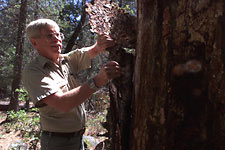| BASS LAKE -- Hundreds of beetle-infested pines are dying
and forming large brown patches on the otherwise green landscape
in this popular mountain recreation area.
"It's happening all the way around the lake," says Paul
Henry Abram, who moved to the lakefront community 18 months
ago from Hanford. "It's going to probably get 10 times as
bad. ... A lot of [trees] are just absolutely brown."
 |
Skip Howard
of the Sierra National Forest peels back the bark of a
dying ponderosa pine tree near Bass Lake, looking for
evidence of the beetle infestation that is killing hundreds
of trees in the area.
(Photo by John Walker / The Fresno Bee) |
The quarter-inch-long beetles are a large problem, threatening
hundreds of the tall trees in the federally managed Sierra
National Forest.
The primary culprits are the western pine beetle and the
ips beetle. After they have turned green, healthy trees into
brown, sickly ones, mountain turpentine beetles arrive to
share in the feast. And when the beetles are finished, so
are the trees.
The beetles have affected "a few hundred trees" in the area
around North Fork, Oakhurst and Bass Lake, says district ranger
Dave Martin in the North Fork office of the Forest Service.
The beetles take out a section of trees by destroying one
tree and moving to the next.
The beetle infestation runs in cycles of eight to 10 years.
Long, hot summers increase the beetle population, and drought
limits pines from making sap, a natural defense against the
pest.
Trees can better combat the beetles if they have more ground
water to produce more sap, officials said.
In the meantime, Abram says, the Forest Service needs to
attack the insects with sprays and treat some trees with Vitamin
B, which has been successful in battling the pests in other
areas.
Sierra National Forest has no money to battle the beetles
-- either forestwide or one tree at a time. For now, federal
officials are watching and waiting for nature to ease the
problem.
But Abram is concerned that without federal intervention,
the infested trees are being allowed to die so they can be
sold for logging. The 61-year-old lawyer estimates that hundreds
of trees around the lake are affected.
Abram adds that the infested trees could lead to widespread
salvage logging, and new roads through the forest.
"It's not a very conservationist program," Abram says.
Martin says the beetle-infested, dead trees are fuel for
faster-burning and hotter wildfires. Some of the area's trees
are marked for sale to commercial loggers.
"The pockets of trees that we've identified ... roads won't
be needed for any of these," Martin says of commercial logging.
"There will be some minimal amounts of logging to take care
of many of these."
Along Road 274, a giant osprey perches with its nest atop
a dead pine. But other dead trees near lakeshore roads or
power lines are marked for early removal.
Nearby, Forest Service workers have painted blue bands around
the trunks of two tall but brown trees. They are close to
power lines and will be cut before they can fall across the
lines and spark a forest fire.
Madera County Supervisor Gary Gilbert can see some of the
infested trees from his North Fork home. Gilbert, a retired
California Department of Forestry chief and former Madera
County fire chief, says the dead trees can fuel intense forest
fires.
Natural fire is part of the ecosystem. Historically, low-intensity
flames have cleansed the forest of dead trees and thick underbrush.
Forest fires also kill insects.
But a century-old policy of dousing all wildland fires and
the continuing construction of homes, shopping centers and
resorts in mountain communities have added to the potential
for danger.
Deliberate burning of dead trees such as those in the Sierra
National Forest could quickly sweep out of control through
underbrush grown thick after decades without cleansing, low-intensity
fires.
"Where these trees are grouped and it's economical, they
should be logged," Gilbert says about the dry pines.
The reporter can be reached at cmcarthy@fresnobee.com
or (559) 675-6804.
|